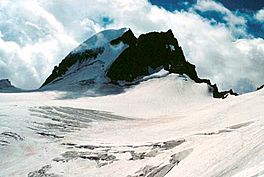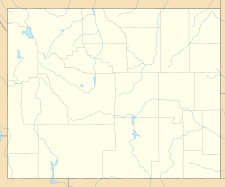Gannett Glacier facts for kids
Quick facts for kids Gannett Glacier |
|
|---|---|

Gannett Glacier on the north slope of Gannett Peak
|
|
| Type | Mountain glacier |
| Coordinates | 43°11′45″N 109°38′44″W / 43.19583°N 109.64556°W |
| Area | 3.63 square kilometres (897 acres) (in 1999) |
| Terminus | Moraine |
| Status | Retreating |
Gannett Glacier is the largest glacier in the Rocky Mountains found in the United States. This huge ice mass sits on the east and north sides of Gannett Peak. Gannett Peak is the tallest mountain in Wyoming. The glacier is located on the east side of the Continental Divide in the Wind River Range. Gannett Glacier is one of many glaciers in the Fitzpatrick Wilderness area of Shoshone National Forest.
Contents
About Gannett Glacier
Gannett Glacier is a very important natural feature. It is the biggest glacier in the American Rocky Mountains. A glacier is like a very slow-moving river of ice. It forms over many years from layers of snow that get packed down.
Where is Gannett Glacier?
You can find Gannett Glacier in Wyoming, a state in the western U.S. It's high up on Gannett Peak, which is the highest mountain in Wyoming. This area is part of the Wind River Range, a large mountain chain. The glacier is also within the Shoshone National Forest, a protected natural area. Many other glaciers are nearby, including six that are among the ten largest in the U.S. Rocky Mountains.
Why is Gannett Glacier Shrinking?
Like many glaciers around the world, Gannett Glacier is slowly getting smaller. Scientists have seen this change clearly through photos taken since the 1920s. In 1950, the glacier covered about 4.6 square kilometres (1,137 acres). By 1999, it had shrunk to about 3.63 square kilometres (897 acres). This means it lost almost 20 percent of its size in less than 50 years!
Measurements also show the glacier is getting thinner. Between 1958 and 1983, its depth decreased by about 18.6 metres (61 ft). Experts believe a general warming trend and less snowfall are causing the glacier to melt and shrink. This process is called glacial retreat.
What Happens When Glaciers Melt?
In 1989, scientists studied Gannett Glacier and another nearby glacier called Dinwoody Glacier. They wanted to see how much meltwater these glaciers added to streams. Both glaciers feed water into Dinwoody Creek, which then flows into the Wind River.
The study found that the glaciers were supplying less and less meltwater to the creek. This is because the glaciers are getting thinner and smaller, especially since 1950. When glaciers shrink, they provide less water to the rivers and streams below them. This can affect the local plants and animals that depend on the water. It also impacts farms and ranches downstream that use the water for their crops and animals.


